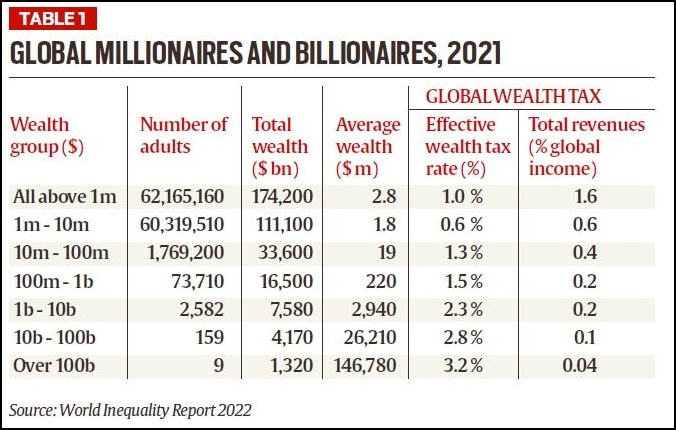Context
-
India stood out in terms of income and wealth inequality, claimed the World Inequality Report 2022.
Key Findings of World Inequality Report 2022
Key findings for India
- “India stands out as a poor and very unequal country, with an affluent elite,” the report says. It says India’s middle class is relatively poor with an average wealth of Rs 7,23,930, or 29.5% of the total national income, compared with the top 10% and 1% who own 65% (Rs 63,54,070) and 33% (Rs 3,24,49,360), respectively.

- The average annual national income of the Indian adult population is Rs 2,04,200 in 2021.
- The bottom 50% earned Rs 53,610, while the top 10% earned over 20 times more (Rs 11,66,520), the report states.
- The average household wealth is Rs 9,83,010, of which the bottom 50% owns Rs 66,280, a mere 6%.
- The share of the top 10% and bottom 50% in pre-tax national income has remained broadly constant since 2014. The quality of inequality data released by the government has seriously deteriorated, making it particularly difficult to assess recent inequality changes, the report says.
-
- As per the recent Multi-dimensional Poverty Index prepared by Niti Aayog, one in every four people in India was multi-dimensionally poor. Bihar has the highest such proportion (51.91%), followed by Jharkhand (42.16%) and Uttar Pradesh (37.79%).
Pandemic impact
- The impact of the pandemic was reflected in a drop in global income, which was impacted significantly due to India. “When India is removed from the analysis, it appears that the global bottom 50 per cent income share actually slightly increased in 2020.
- Also, even as countries have become richer over the last 40 years, their governments have become significantly poorer, a trend magnified due to the pandemic.
- The share of wealth held by public actors is close to zero or negative in rich countries, meaning that the totality of wealth is in private hands. This trend has been magnified by the Covid crisis, during which governments borrowed the equivalent of 10-20 per cent of GDP, essentially from the private sector.

- The rise in private wealth has also been unequal within countries and at world levels. Since the mid-1990s, the top 1% globally took 38% of all additional wealth accumulated, whereas the bottom 50 per cent captured just 2%. “The wealth of the richest individuals on earth has grown at 6 to 9% per year since 1995, whereas average wealth has grown at 3.2% per year. This increase was exacerbated during the COVID pandemic.
Global, regional trends
- The poorest half of the global population “barely owns any wealth” at just 2% of the total, whereas the richest 10% owns 76%, the report says. The richest 10% currently takes 52% of global income, and the poorest earns just 8% (Figure 1).
- The Middle East and North Africa (MENA) are the most unequal regions in the world, whereas Europe has the lowest inequality levels, the report says.
- In Europe, the top 10%’s income share is around 36%, and in MENA, it is 58%; in East Asia, it is 43%, and in Latin America, 55%.
- Global wealth was equal to around 510 trillion euros in 2020, or about 600% of national income. The ratio of total wealth to total income rose from around 450% in the early 1990s to about 600% today.
- In high-income countries, in 1970, private wealth–national income ratios ranged between 200-400%. By 2008, when the global financial crisis began, these ratios averaged 550%.
- Large emerging economies such as China and India experienced faster increases than wealthy countries after they transitioned away from communism (in China and Russia) or from a highly regulated economic system (in India). In India, private wealth increased from 290% in 1980 to 560% in 2020.
- Global inequalities seem to be about as great today as they were at the peak of Western imperialism in the early 20th century.
Other key inequalities
- Women’s share of total incomes from work was about 30% in 1990, and is less than 35% now, the report notes.
- Inequalities within countries are now greater than those between countries. Within countries, the gap between the average incomes of the top 10% and the bottom 50% almost doubled from 18 times in 1820 to 41 times in 1910, reached an all-time high of 53 in 1980 and 50 in 2000, before declining to 38 in 2020.
- It notes that global income and wealth inequalities are “tightly connected to ecological inequalities and to inequalities in contributions to climate change”. The top 10% of emitters is responsible for close to 50% of all emissions, while the bottom 50% contributes 12%.
If the rich were taxed
- The report has suggested levying a modest progressive wealth tax on multimillionaires.
- In 2021, there were 62.2 million people owning more than $1 million (measured at market exchange rates). Their average wealth was $2.8 million, a total of $174 trillion. More than 1.8 million individuals (top 0.04%) own over $10 million, 76,500 (0.001%) own over $100 million, and 2,750 (0.00005%) own more than a billion dollars. The billionaires own more than $13 trillion, or 3.5% of global wealth (Table 1).
- A global effective wealth tax rate of 1.2% for wealth over $1 million, the report said, could generate revenues of 2.1% of global income. A tax rate of 0.6% for wealth between $1-10 million can yield 0.6% of global income, a 1.1% rate for wealth group $10-100 million can generate 0.4% of global income, and a 5% rate for wealth between $1 billion and $10 billion could generate 0.3% of global income.
Visit Abhiyan PEDIA (One of the Most Followed / Recommended) for UPSC Revisions: Click Here
IAS Abhiyan is now on Telegram: Click on the Below link to Join our Channels to stay Updated
IAS Abhiyan Official: Click Here to Join
For UPSC Mains Value Edition (Facts, Quotes, Best Practices, Case Studies): Click Here to Join
